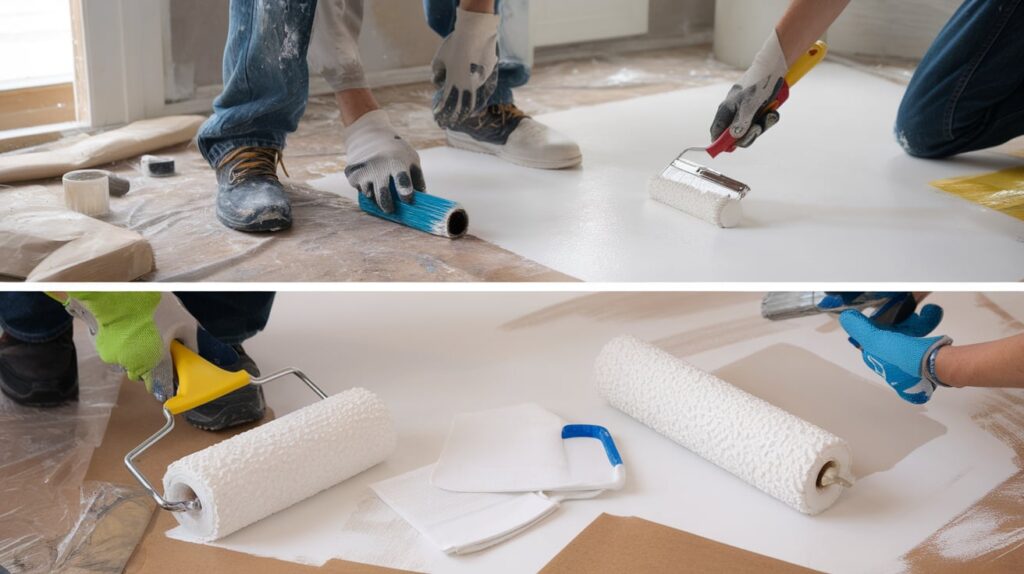If you’re thinking about painting a room, you’re probably wondering how long it will take.
If it’s your first time or you’ve done it before, getting a good idea of the time involved helps you plan better.
The truth is, the time it takes can vary depending on several factors, such as the room size, the number of coats required, and the amount of prep work needed.
I’m here to break it all down for you, so you know exactly what to expect.
I’ll walk you through the main factors that can speed up or slow down your painting project, and give you practical tips to make the process smoother.
By the end, you’ll have a clear plan and a better understanding of how long it takes to paint a room.
How to Estimate Painting Time for Your Room

Estimating how long it will take to paint a room is easier than it sounds. Start by measuring the perimeter of the room and multiplying it by the ceiling height to get the total wall area.
Then, use a guideline of 0.76 minutes per square foot. This means for each square foot of wall, it will take about 0.76 minutes to paint.
Multiply the wall area by this number to get a rough estimate of how long it will take to paint your room.
If you need to apply multiple coats or if there are features like windows, doors, or repairs to be done, you’ll need to add extra time.
These factors can affect the overall time needed.
By following this simple method, you’ll have a good idea of how long your painting project will take and can plan your day accordingly.
Painting a Room: Professional vs. DIY Timelines

When it comes to painting a room, how long it takes can depend on whether you hire a professional or decide to tackle the job yourself.
- Standard 12×12 Bedroom: Professionals can usually paint this size room in 4–6 hours, while DIYers might take 8–12 hours.
- Living Rooms and Larger Spaces: These rooms can take anywhere from 5–10 hours or more, depending on the complexity and size.
- Small Rooms or Accent Walls: These can be done in just a few hours, especially if you’re just adding a quick pop of color.
In general, professionals tend to work faster, especially when it comes to prep and technique, while DIYers may take longer as they may not have the same tools or experience.
Key Factors That Affect Painting Time
Several factors can influence how long it takes to paint a room. From the size of the space to the prep work involved, these elements will determine your timeline. The most important things to consider are:
- Room Size: Larger rooms take more time due to the increased surface area. Smaller rooms or accent walls will generally be quicker to paint.
- Condition of the Walls: Walls that need repairs (cracks, holes, or texture issues) will add extra time for prepping before you even start painting. Smooth, clean walls are faster to work with.
- Number of Coats: Multiple coats of paint are often necessary for full coverage and color richness. Each coat requires drying time and adds to the overall time spent.
- Drying Time: Paint needs time to dry between coats, and this can vary depending on the type of paint, room temperature, and humidity. Be sure to factor in drying time.
- Tools and Experience: Professionals typically work faster with better equipment and more experience. If you’re a DIYer using basic tools, it may take longer to get the desired finish.
- Help and Assistance: Having extra hands can speed up the process. With more people, tasks can be divided, allowing for faster completion.
Tips for Speeding Up the Painting Process

Want to get your painting project done faster? These tips will help you work more efficiently and reduce the time spent on each step so that you can enjoy your freshly painted room sooner.
- Prep Efficiently: Minimize prep time by using drop cloths to protect your furniture and floors. Tape edges properly to avoid messy lines and make the process smoother.
- Use Fast-Drying Paints: Consider using latex paints or other fast-drying options. These types of paint dry quickly between coats, allowing you to finish faster.
- Enlist Help: Having an extra pair of hands can speed things up. One person can handle cutting in around the edges, while the other can roll the walls, cutting down on the overall time needed.
- Use Quality Tools: High-quality brushes and rollers can make the job easier and faster. They hold more paint, apply it more evenly, and require fewer strokes, giving you a smoother finish in less time.
How Long Does It Take to Paint a Room for Different People?

The time it takes to paint a room can vary depending on whether you’re doing it yourself, hiring help, or working with more experience. This is what to expect from different scenarios:
1. First-Time Painters: If you’re new to painting, it will likely take longer. Expect to spend more time learning the ropes, setting up, and getting used to the process. A small room might take 8-12 hours, while larger rooms could take a full day or more.
2. Experienced Painters: For those with some experience or seasoned DIYers, painting goes faster. You’ll be able to work more efficiently, potentially completing a standard room in 4-6 hours or less.
3. Professional Help: Hiring professionals means the job will be done much faster, with experts handling the prep, painting, and cleanup.
A professional team can usually finish a standard room in 4-6 hours, depending on the scope of work.
Common Mistakes to Avoid That Can Waste Time

Avoiding these common mistakes can save you time and help your painting project go smoothly. Here’s what to watch out for:
- Skipping Prep Work: Neglecting the prep work, like cleaning the walls or covering furniture, can lead to mistakes and delays later. It may seem like a time-saver, but skipping prep often results in uneven paint or extra touch-ups, extending the project.
- Overlapping Coats Before Drying: Applying a second coat before the first one has dried can lead to smudging and uneven coverage. Always wait for the first coat to fully dry before adding another, ensuring a smooth and clean finish.
- Inadequate Cleanup: Cleaning your brushes and rollers as you go or after each session helps prevent dried paint from ruining your tools. Keeping things organized will also save time on the final cleanup and make the whole process more efficient.
Conclusion
Painting a room doesn’t have to be a stressful or time-consuming task if you plan ahead.
By understanding how long it will take and considering factors like room size, number of coats, and your experience level, you can create a realistic timeline for your project.
If you’re a first-time painter, expect to take longer, but don’t let that discourage you-it-it-it’s all part of the learning process!
Experienced painters and professionals can speed things up, but with the right tools and help, even a DIYer can get the job done faster.
Remember, prepping the room and using quality tools can make a huge difference.
Avoiding common mistakes, like skipping prep work or not letting coats dry properly, will save you time in the long run.
With these tips, you’ll be able to tackle your painting project with confidence and finish it in no time

